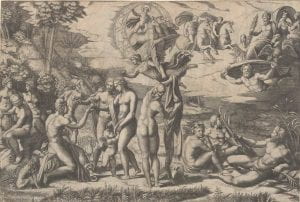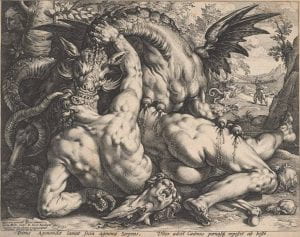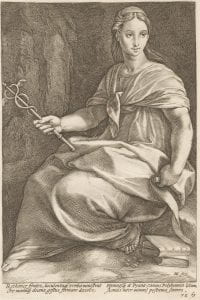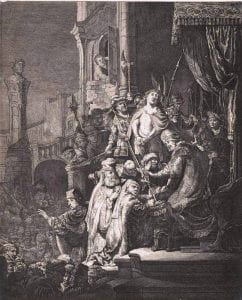Methods of intaglio printing: Engraving versus etching
Intaglio printing is the opposite of relief printing. This term encompasses a variety of print-making methods in which an image is created as incised sunken lines on a printing plate, rather than as raised ones. Studying the art of printmaking, it is necessary to grasp the difference between engraving and etching, two techniques of intaglio printing. While deceptively alike to the untrained eye, both in name and look, these two methods developed from different processes, were mastered by differing artists, and create dissimilar effects on the finished print.

The art of engraving appears to have originated from goldsmithing techniques. The German Martin Schongauer (c.1450-1491) was the son of a goldsmith, and his work in the 1470s such as The Death of the Virgin laid the foundations for engraving as an art form. In Italy, Florentine goldsmiths filled incisions in niello plaques of silver or gold with a dark substance to shade a design, thus serving as a precursor to engraving. As the method engraving progressed throughout the 16th and 17th century, artists added their own innovations and developed their own unique styles. Lucas van Leyden (c. 1494-1533) achieved dimensional depth in his engravings by putting less pressure on the burin while carving the background. Marcantonio Raimondi (c. 1480-1534) successfully transposed the painter Raphael’s The Judgment of Paris (1510-20) into an engraving through his complex hatching system, creating smooth, round tones throughout the image. In Adam and Eve (1504), the great Albrecht Dürer (1471-1528) achieved a mindboggling density of fine lines, his work a stunning blend of form, shading, and texture.
The basic process of engraving involves a burin, a small bevelled diamond-shaped metal tool to carve lines into a piece of metal, usually copper or zinc. While an engraver can freehand onto the metal, due to the complexity of most engravings it is common to begin with a drawing. A thin layer of wax can be pressed on to the metal plate, onto which the artist can trace the lines of their drawings, thus providing a guide for their carving. Once finished, ink is then smoothed over the carved metal plate; with all excess ink removed, the plate and a sheet of dampened paper are passed through a printing press roller, thus forcing the ink held in the incising onto the paper. The resulting image is a reversed copy of that on the original plate.
Hendrick Goltzius (1558-1617), hailed from the Lower Rhine region of Germany. His engravings became known for their virtuosic, swelling lines, creating remarkable shape and curve. Associated with the Northern Mannerism movement, and its vision for drama and exaggeration in contrast to the mathematical perfection preferred during the High Renaissance, Goltzius’ earlier work displays an almost hedonistic level of flair. In The Dragon Devouring the Companions of Cadmus (1588), blood spills from the muscular bodies of naked men, surrounded by the bones and heads of their fallen companions, as they are mauled by a whiskered dragon. Goltzius’ signature swelling and tapering line adds movement and an ostentatiousness to the rippling muscles of the men and the beast.


Goltzius’ The Venetian Ball (1584) demonstrates Mannerism’s shift away from biologically realistic proportions, with densely robed and rotund bodies topped with tiny heads. However, after a visit to Italy in 1590, he was left inspired by the classical statues, and this is reflected in his later work. Polyhymnia, Plate 8 of ‘The Nine Muses’, is an example of how Goltzius’ moved towards more classical proportions and subject matter, while maintaining great depth and movement in his engravings due to his extravagant use of the swelling and tapering line. While he moved towards painting later in his career, Goltzius remains one of the most significant engravers of the 16th century.

A key difference between the process of engraving and etching is the use of acid. Inspired by techniques used in the armourer’s trade, a metal plate is covered in a thin layer of acid-resistant wax, called the “ground”. Being careful as to not remove too much wax to avoid acid bleeding over the plate, the artist then creates an image in the wax, before submerging the plate into a bowl of nitric acid. The acid eats into the metal where the wax has been removed, thus creating a design in the metal plate. With the wax removed, an etching plate can then be printed in the same manner as an engraving plate. The process of etching is accessible for anyone able to draw into the wax, therefore requiring a less precise skillset than carving directly into a metal plate, as for engraving.
Etching was first practiced in the early 16th century, and was practiced using iron plates. Artists moved to using copper plates, and in the mid-1600s, Rembrandt van Rijn (1606- 1669) mastered the medium and produced over three hundred etchings, utilising the artform’s ability to create a sense of light and air in an image. Unlike paintings, etchings could be reproduced and disseminated to larger audience. The renown enjoyed by Rembrandt during his lifetime was due to his immense talent as an etcher. The lines of an engraving, cut into the metal, are distinct and firm, while the acid eroded lines of an etching are softer and more wavering. Rembrandt did not shy away from this aspect of the artform, instead allowing soft shadings of grey and a shadowy atmosphere into his work.

In Christ Before Pilate, Rembrandt achieves an effect almost like shading from a graphite pencil in the sky and buildings of the image, and the soft faces seen in the crowd of spectators contrast with the clear brightness of Christ. This skill of Rembrandt’s, in exploiting the process of etching to bring a gentle ashy depth to the finished piece, was suitable not only for sombre biblical scenes, but also for his studies of the poor and dispossessed.

The ashy tones of the etching provide a realistic grime to this scene of the hungry and burdened family. Rembrandt’s use of his medium provides a sense to the viewer rather than immortalising the legendary and beautiful in his work. Rembrandt wanted to capture the world as he saw it, in all its propensity to be bleary and ill-defined.
Identifying an etching from an engraving can still be tricky even when one is aware of the difference in how they are made. While most intaglio artists tended to lean towards one method or the other, some artists dabbled in both, combining the techniques in the same artwork. A distinguishing clue is the firmness of the line and the presence, or lack thereof, of any grey shades. Engraving lines, even if swelling and tapered, are firm and constant, whereas etching lines have a softer and very slightly wobbly shape to them. Engravings also tend to be strictly lines contrasted on a pale background, unlike the process of etching with allows for larger sections of a grey in-between. Both effective and visually stunning in their own right, engraving and etching require a great deal of skill; processes of printmaking since the 16th century have allowed artworks to be seen and enjoyed by larger audiences, bringing the joy of art form into the lives of many.
Adelaide Greig
Print Room Intern
References and further reading
Huigen Leeflang and Ger Luijten, editors. Hendrick Goltzius (1558-1617): Drawings, Prints and Paintings, (Waanders & The Metropolitan Museum of Art), 2003.
Thomas Rassieur, and William Robinson et. al, editors. Rembrandt’s Journey: Painter, Draftsman, Etcher, (Boston: MFA Publications), 2003.
Wendy Thompson. “The Printed Image in the West: Engraving.” In Heilbrunn Timeline of Art History, (New York: The Metropolitan Museum of Art), 2003.
Wendy Thompson. “The Printed Image in the West: Etching.” In Heilbrunn Timeline of Art History, (New York: The Metropolitan Museum of Art), 2003.
Gerald W. R. Ward, editor. The Grove Encyclopaedia of Materials and Techniques in Art, (Oxford: Oxford University Press), 2008.
Categories
Leave a Reply